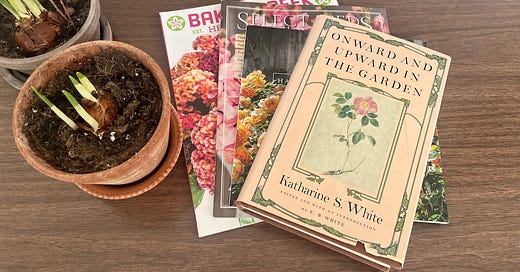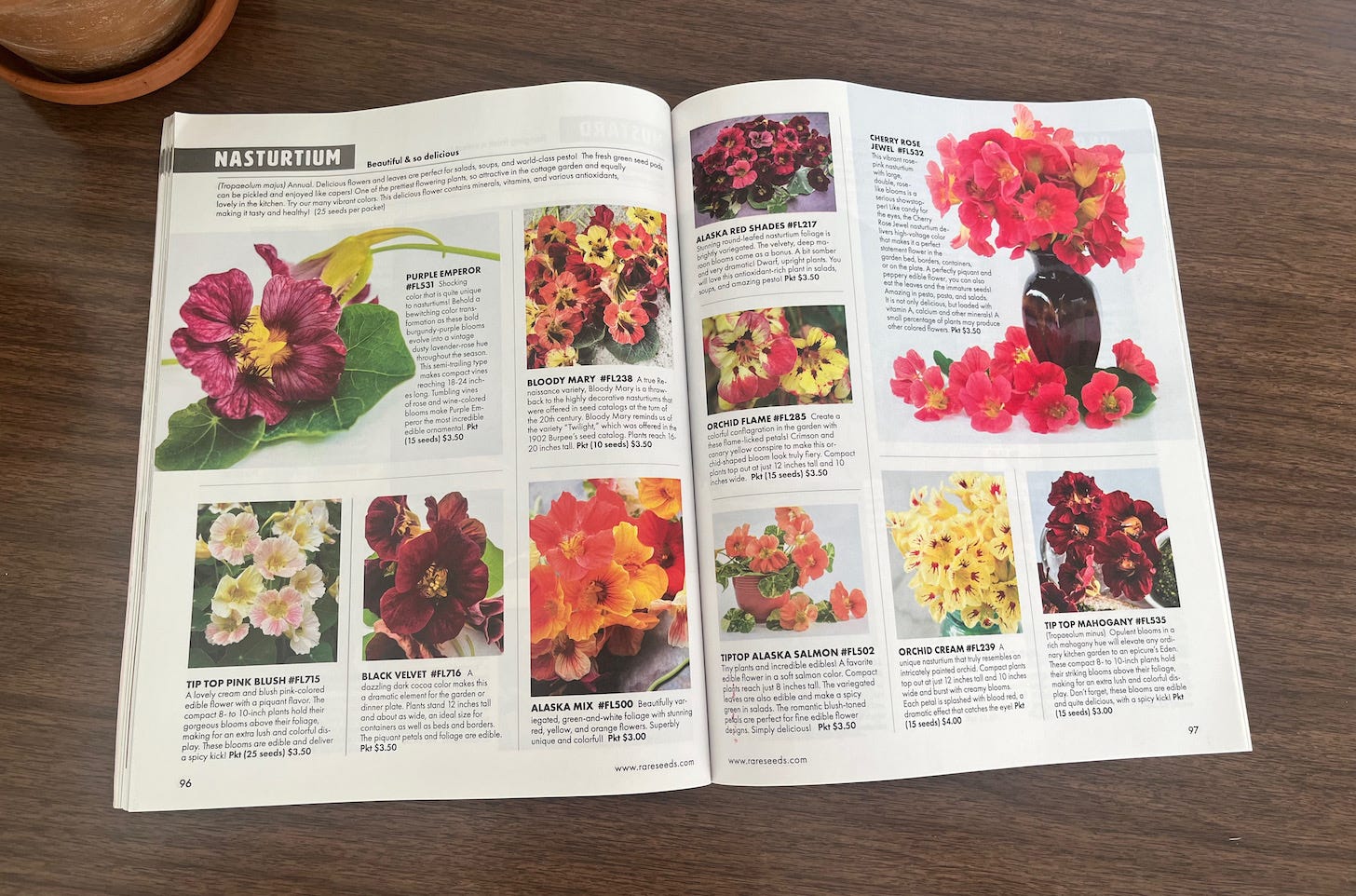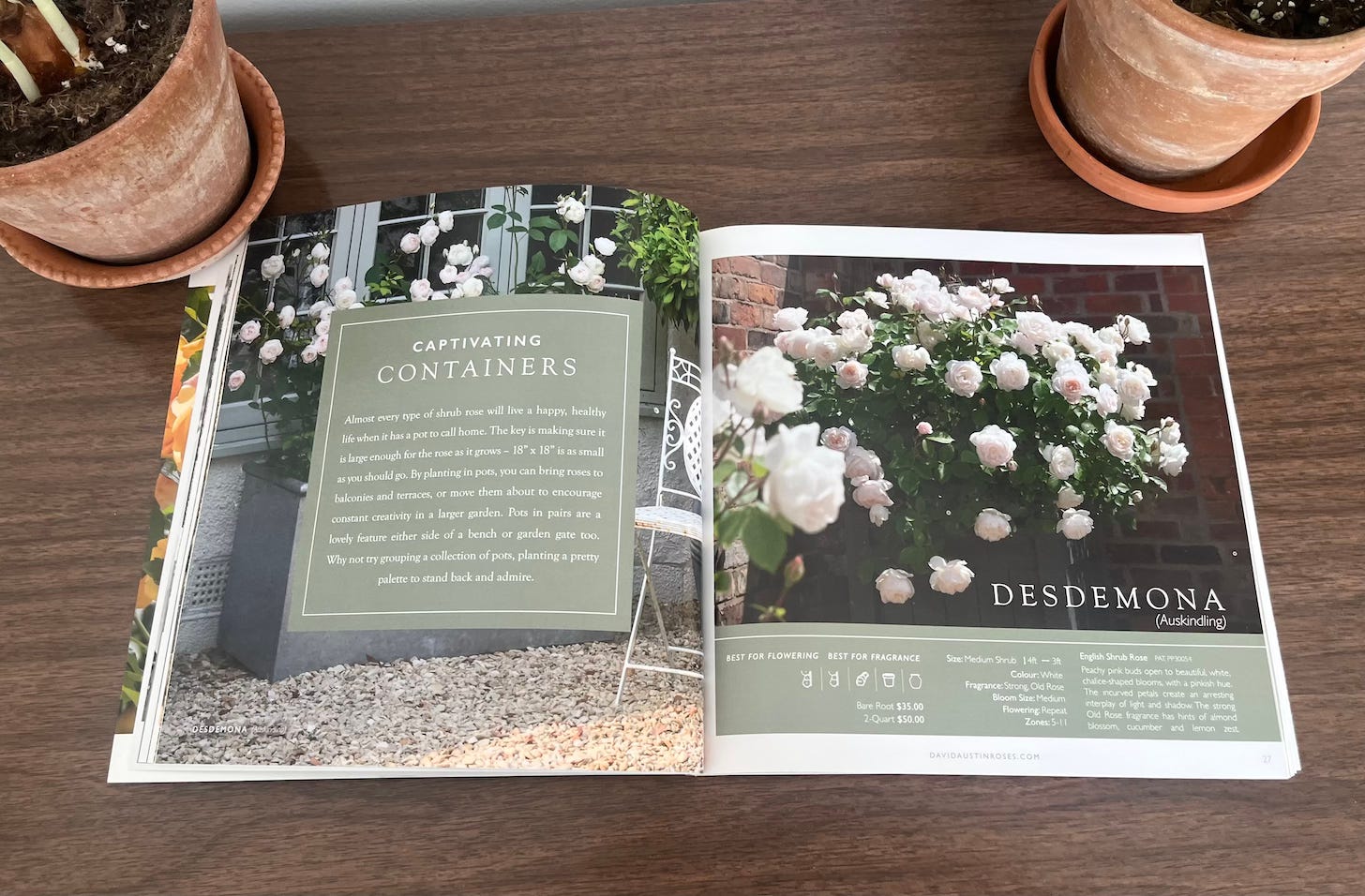My garden catalogs have already been romped through and raided, all seeds bought. (For now, at least—who knows what I’ll be impulse buying later this year) I always try to put off looking through seed catalogs until after Christmas because I don’t want the fun of the holiday season and the gardening season mixing and combining into something that’s too much fun for me to take. But by the time I grab a stack of catalogs and a cider and start flipping through the colorful pages, the tree is usually still up and the air outside is still brisk and the Christmas lights are still twinkling, and all that’s missing is a fire in the fireplace we don’t have here in our Brooklyn apartment. No matter—it’s cozy enough without it.
I do sometimes wonder if it’s wasteful for me to order catalogs in the mail when I can (and do) go to the seed company websites to order. Maybe. Probably. But I do love them. There’s just something so satisfying about holding a seed catalog in your hands and thumbing through the pages. I like reading the company owner introductions—sometimes folksy, sometimes formal—and I like seeing the way the products are arranged, complete with photos that can be cut out and garden vision-boarded. A physical catalog tells a story in a way that a website just can’t.
I’ve looked forward to getting new catalogs in the mail ever since I started gardening, but I don’t think I gave them their proper due until stumbling across Katharine S. White’s book Onward and Upward in the Garden in the basement at Strand Books. How did I never hear about her before? Katharine, a founding editor of The New Yorker, often described as “formidable” and instrumental in the magazine’s literary reputation, editing the works of Mary McCarthy, Vladimir Nabokov, and John O’Hara during her time there, and married to fellow New Yorker writer E.B. White, nevertheless considered garden catalog writers to be her favorite authors.

Katharine even properly reviewed garden catalogs in The New Yorker’s books section, which is amazing to think about. In her very first column, “A Romp in the Catalogues,” she explains why a very serious magazine editor is reviewing garden catalogs in the first place: “They are as individualistic—these editors and writers—as any Faulkner or Hemingway, and they can be just as frustrating or rewarding.” Then she goes right to town on everything that’s wrong with the modern hybrids being sold (she especially hated that new zinnia varieties were being made to look like dahlias or chrysanthemums or cactuses when they could just stick to looking like zinnias).
Katharine critiqued catalog covers, plant photos (or lack thereof, which I can’t even imagine—how did customers know what they were getting?), even typography. But she mostly wrote about writing, which there seemed to be a lot more of in those 1950s garden catalogs. “Reading this literature is unlike any other reading experience,” wrote Katharine. “Too much goes on at once. I read for news, for driblets of knowledge, for aesthetic pleasure, and at the same time I am planning the future, and so I read in dream.”
I haven’t received too many catalogs in the mail this year, but reading Onward and Upward in the Garden is making me want to give the few I did get a closer look. This is no New Yorker (and I’m definitely no Katharine S. White!), but a little catalog critiquing is always fun . . .
Baker Creek Heirloom Seeds
So my very favorite thing about Baker Creek is the fact that they have free shipping on seeds here in the US. It’s also a very dangerous thing. I don’t usually place my big seed orders with them, but by the end of the season I somehow alway have a bunch of random Baker Creek packets that I’ve ordered along the way. I’m sure I will by the end of this year, too.
There’s a flower on the cover of this year’s catalog—some kind of grotesque looking celosia. I’m sorry if you grow it. It just kind of looks like brains to me—but I’m pretty sure that Baker Creek specializes in vegetables and fruits. When we grew vegetables I bought most of my seeds from them—lots of interesting varieties, a little bit hippie. They have a lot of flowers, too, though in the catalog they’re interspersed with the vegetables, all listed in alphabetical order. Why? “Only the catalogue addict will understand what a comfort so simple a thing as alphabetical order can be,” wrote Katharine. I disagree. I find it so much more helpful when plants are grouped together by theme or purpose. At least group the flowers together!
Of course I’m just looking through the free catalog that Baker Creek sends out. Maybe their 532-paged Whole Seed Catalog is more helpfully organized? It costs $14.95, and supposedly it’s the biggest seed catalog in the world, complete with “enticing recipes” and “captivating stories.” It does sound a little enticing . . .

Select Seeds
There aren’t any vegetables to be found in Select Seeds’ catalog, and better yet for the flower grower it’s actually organized well! No alphabetical order nonsense here—from the table of contents you can easily flip to sections on cottage garden annuals, flowers for pollinators, heirloom plants, and, happily for me, container garden annuals. So smart. Why don’t more catalogs organize this way?
I like the owner/founder introduction too, but find myself wanting to know more. Select Seeds is “proudly 100% women-owned & women run” (a plus—there can never be too much ‘feminine energy’ in my book, especially these days), founded by Marilyn Barlow and her daughter Allison. Marilyn writes a little about their time hunting for sweet peas in England, but I want more stories! The more captivating the better.
Anyhow, captivating stories or not I guess I’m sold, since I already ordered a bunch of my seeds for this year from them, thanks to a gift card I got from my mom for Christmas. On my list for 2025: Cosmos ‘Rosetta,’ Salvia ‘Brenthurst Pink,’ Asarina ‘Sky Blue,’ Phlox 'Crème Brûlée,' and Cobaea Scandens ‘Alba.’ The company is based in Connecticut, not too terribly far from me, so I’m hoping the seeds do well for me here in New York.
Update: I just got a second catalog from Select Seeds in the mail, seemingly the same content inside, but with a different cover (the first one featured cosmos ‘Apricotta’), and it has that same brains-looking celosia on it! What is happening?
David Austin Roses
If there’s a prettier plant catalog than David Austin’s I haven’t seen it yet. I’m not even ordering any roses this year, but I still had to put aside a special moment to flip through the 2025 catalog. It reminds me of the twenty dollar European fashion magazines I’d buy once in a while back in my fashion blogging days. (Remember Lula? I was such a fan) Even the paper feels fancy—matte and thick. I find myself wanting to cut out photos but end up feeling too guilty to do so.
The catalog is laid out in grids and squares, and looks like the prettiest flower instagram account you can think of. And the photos—they’re beautiful, of course, but the company does have some very photogenic roses to work with. I say I’m not buying a rose this year (and I’m not!) but the newly released Dannahue is doing its best to tempt me.
But it’s not just all tasteful graphic design and romantic photography. There’s lots of helpful information: rose planting instructions, rose care tips for every region (I’ve got the US catalog here), beautiful rose recipes from Jo Thompson. There’s even a rose index at the back, where every single rose is pictured and grouped by color to help you choose which one(s) to get.
Katharine S. White wrote about borrowing a certain rose company’s catalogs from her friend, a beauty parlor owner who never bought a rose from the company but still read the catalogs every night before going to sleep. I wonder if she lived in the city like I do? Because getting lost in an extra beautiful plant catalog is so escapist for me, too, and in a more wholesome way than, say, the fashion magazines I used to get lost in. Reading the David Austin catalog lets me imagine I’m somewhere in England, growing a Claire Austin rose up the walls of a honey-colored stone cottage, or planting a Desdemona in an old-fashioned flower garden somewhere in the American Northeast—maybe a garden just like Katharine’s in Brooklin, Maine. As it is I’m here in an entirely different sort of Brooklyn, but a catalog can help me dream, and I guess that’s the point.









A love letter to catalogs! Genius. I also ordered the bulk of my seeds from Select Seeds, and I love how their seed packets also have a corresponding photo of the flower.
Oh gosh I love plant and seed catalogs. Not such a big thing here in Australia but I reap as much pleasure as I can from the ones I find. 💕